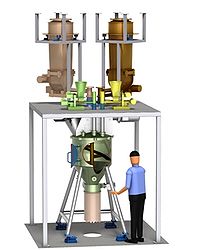Continuous Mixers
A continuous mixer is a large piece of industrial equipment used to blend different ingredients together. It may be used in a variety of different industries, including food production, chemical manufacturing, pharmaceutical testing and manufacturing, and plastic/composite production. More compact continuous mixtures can also be used out in the field to mix concrete for construction projects.
Operation Processes
The discharge valve of the mixer is closed. All the gravimetry working dosing components are started simultaneously with small mass flow and tune themselves automatically in relation to one another. The level of the mixing vessel fills up continuously, starting up the mixer when it reaches half capacity. Tuning is completed once the mixer is filled to half its capacity approximately. The discharge device opens slowly once the mixer is filled at approx. 80% of cubic capacity. A filling level of 80% is kept constant. The dosing flows are increased up to the maximum mass flow while maintaining a constant synchronization.
All dosing components gradually slow down the mass flow and then switch off at the same time. The mixer discharges the mixture continuously until it is completely empty.
Advantages
A continuous mixer is often the best choice for high volume projects where speed and efficiency is a priority. It should only be used when mix ratios can differ between batches. When more specific ratios are required, batch mixing is typically the better option. Some manufacturers may even use continuous mixing to smooth out many different batch mixes to make the finished product more homogeneous. In this scenario, each batch is removed from the batch mixing equipment and fed into the continuous mixer along with all other batches.
Continuous mixer equipment is associated with a number of benefits that are not found with batch mixing. Continuous mixing is much faster, and requires a smaller number of staff. The process of feeding ingredients is automated, and the batches are fed out automatically without the need for refilling or removal. Continuous mixers are often smaller and more economical than batch mixers, which tend to take up more floor space and require more components. Finally, there is less variation between batches than is typically found with batch mixing equipment.
At the same time, a continuous mixer may not always be the best choice for every application. It offers less flexibility than a batch mixer, and results in fairly imprecise batches. Pharmaceutical companies producing medicines that require precise ingredient ratios should not typically use continuous mixers. These mixers are also difficult to maintain and calibrate, and can require more maintenance and repair than batch mixing equipment.
Video
